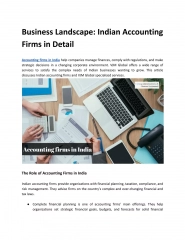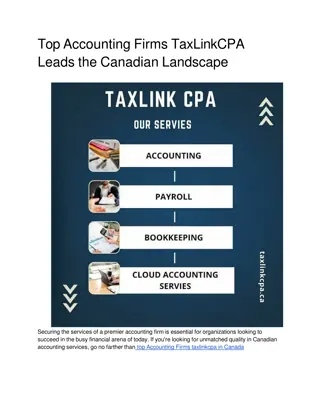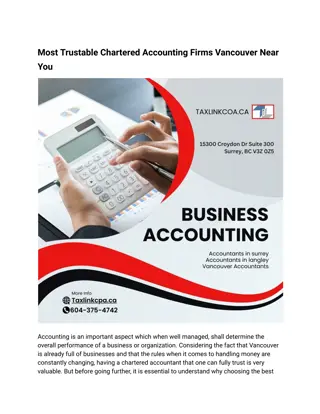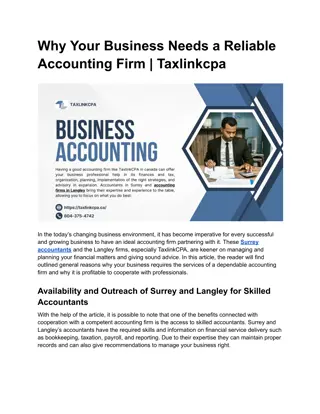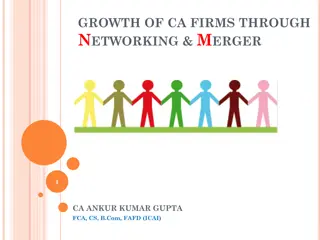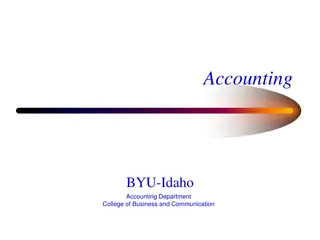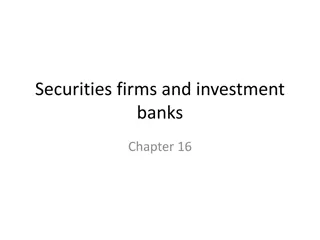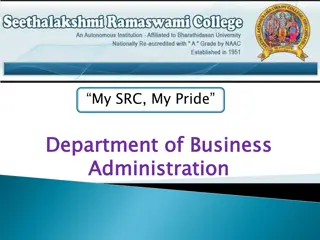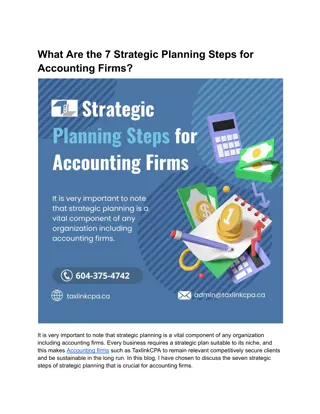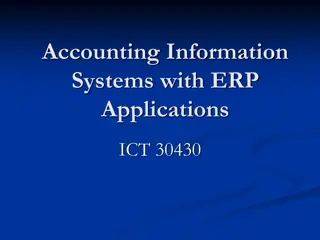Introduction to Accounting Information and Economic Events in Business Firms
This e-learning programme covers the use of accounting information in profit and not-for-profit trading organizations. It explains the meaning of business, types of business firms, economic events, and the definition of accounting. The content also discusses the American Accounting Association's definition of accounting, focusing on identifying, measuring, and communicating economic information for informed decision-making.
Download Presentation

Please find below an Image/Link to download the presentation.
The content on the website is provided AS IS for your information and personal use only. It may not be sold, licensed, or shared on other websites without obtaining consent from the author. Download presentation by click this link. If you encounter any issues during the download, it is possible that the publisher has removed the file from their server.
E N D
Presentation Transcript
WELCOME TO DISTANCE E-LEARNING PROGRAMME LAUNCHED BY AEES , MUMBAI N. Paranjothi PGT (SS)Commerce AECS KAIGA
Content 1.Meaning and Types of business firm 2.Economic events 3.Definition of accounting and concept 4. 0bjectives of accounting information 5.Advantages and limitations of accounting information 6.Types of accounting information 7.Users of accounting information and their needs N. Paranjothi PGT (SS)Commerce AECS KAIGA
Let as know first Where the accounting information is used ? It is used in Profit Trading and not-for- Profit Trading organisation. Meaning of business Exchange of goods and services between person to person and from place to place with money value is known as business. Definition of business Business refers to those economic activities, which are connected with the production or purchase and sale of goods and services with main object of earning profit Types of business firm Business firm can be classified in to two. i)Profit Trading organisation: It is established only to earn profit. Ex: Sole Proprietor ship , Partner ship firm, Joint Hindu family business , Co operative societies , Company ii)Not-for- Profit Trading organisation: These organisations are established only to do welfare oriented services, not to earn profit Ex: Hospitals , charitable trust, Educational Institution, libraries etc. N. Paranjothi PGT (SS)Commerce AECS KAIGA
What is mean by economic events ? It consists of transactions and which are measurable in terms of money For example i) Purchase of Machinery and bringing it through transport and installing, keeping it for manufacturing all this activities comprises number of financial transaction ii) Sale of product to customers iii)Rendering service to customers iv)Purchase of material from suppliers v)Payment of office rent to land lord Based on above activities departments are made For example Accounts &Finance , Purchases, stores, marketing , Advertisement . N. Paranjothi PGT (SS)Commerce AECS KAIGA
The American Accounting Association Defined accounting as the process of Identifying , measuring and communicating economic information to permit informed judgements and decisions by users of information. i)Identification It means determining the transaction which are considered financial character and relate to the organisation For example purchase, sales on cash as well as on credit, payment of wages and salaries are recorded because it is related to financial character For example. value of human resource, change in managerial policies, appointment of personal are not recorded in the books of account N. Paranjothi PGT (SS)Commerce AECS KAIGA
ii)Measurement ( Measuring the quantity of product and its value in terms of money) Measurement means quantification (including estimates) of business unit For example Rupees and Paisa as a measuring unit. if any event cannot be quantified in monitory terms it is not considered for recording in financial transaction For example Purchase of machinery, goods on cash or on credit it is related to money. It can be recorded in the books of accounts. Appointment of a new managing director, signing of contract agreement , transfer of employees are not shown in the books of accounts. iii)Recording ( Accounting Information's are recorded in a separate book ) Once economic events are identified and measured in terms of money in chronological order . After recording it should be summarised as per well established practice and is made available as and when required. For example journal, ledger, trial balance , final account. iv)Communication ( Accounting information's are communicated to users) After the generation of accounting information it should be communicated to Management, Internal users, External users, through proper accounting report to right person in time N. Paranjothi PGT (SS)Commerce AECS KAIGA
1.To provide useful information to interested group of users , both external and internal 2. To maintenance of records of business transactions because no one can remember numerous amount of various transactions such as purchase, sales, receipts, payments etc. 3.To ascertain the profit and loss of the enter prise 4 Preparation of the financial statement also aims at ascertaining the financial position of the business concern in the form of its assets and liabilities at the end of every accounting period. 5.To Provide financial management to the management which help in decision making budgeting and fore casting 6. To prevent frauds by maintaining regular and systematic accounting records N. Paranjothi PGT (SS)Commerce AECS KAIGA
Advantages 1.It helps to maintain the business records in a systematic manner. 2.It helps in the preparation of financial statements 3.It helps to compare the result of current year with previous years to analyse the changes 4. It helps the managers in the decision making process for future course of action. Disadvantages 1.Loss of data or service when business firm is reliant on accounting software, any loss of service due to power failure also possible. 2. It contain only those information's which can be expressed in terms of money. It ignore qualitative elements such as efficiency of management , quality of staff , customer satisfaction 3. System configuration may trouble in between while working on computer 4. It may be affected by window dressing Manipulation and falsification of accounts are possible N. Paranjothi PGT (SS)Commerce AECS KAIGA
Accounting information can be categorised in to the following: 1.Information related to profit & loss i.e., income statement , shows the net profit of business operations of a firm during a particular accounting period . Dr Profit & Loss account Cr Expenses /Losses Rs Incomes/Gains Rs To Salaries 30000 By Gross profit 100000 To Electricity charges 5000 To Balance c/d 65000 100000 100000 By balance b/d 65000 N. Paranjothi PGT (SS)Commerce AECS KAIGA
2. Information relating to financial position i.e., Balance sheet . It shows assets on one side and capital & liabilities on the other side Balance Sheet Liabilities Rs Assets Rs Share capital 500000 Plant & Machinery 450000 Long term loan 100000 Debtors 50000 Current liabilities 50000 Cash in hand 150000 650000 650000 N. Paranjothi PGT (SS)Commerce AECS KAIGA
Branches of Accounting 1. Financial Accounting: It records the transactions related to financial nature in a systematic manner to ascertain profit (or )loss of the accounting period 2. Cost Accounting : which is concerned with ascertainment of total cost and per unit cost of goods or services produced or provided by the business firm. 3. Management Accounting : which is presenting the accounting information in such a manner that helps the management in planning and controlling the operation of a business and in better decision making. N. Paranjothi PGT (SS)Commerce AECS KAIGA
Users Classification Information the user want Internal 1. Owner Return on investment, financial position of their company 2. Management To evaluate the performance to take various decisions. 3. Employees Profitability to claim higher wages and bonus , and also to see whether the firm able to (PF, ESI ,etc ) deposit regularly. N. Paranjothi PGT (SS)Commerce AECS KAIGA
Users Classification Information the user want External 1.Investors and potential investors To know about safety , growth of investments and future benefits 2. Creditor Assessing the financial capability, ability of the business to pay its debts. 3. Lenders Repaying capacity , credit worthiness. 4. Tax Authorities Assessment of due taxes, true and fair disclosure of accounting information 5.Government To compile national income and other information . It helps to take policy decision 6. Others Customers , researchers etc, may seek different information and different reasons. N. Paranjothi PGT (SS)Commerce AECS KAIGA
N. Paranjothi PGT (SS)Commerce AECS KAIGA


